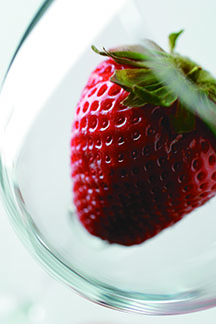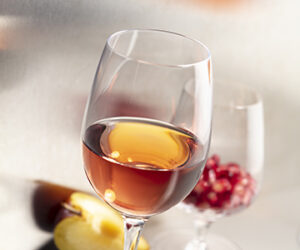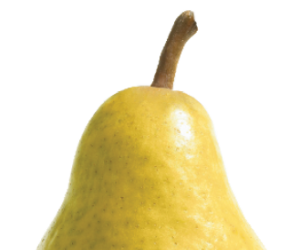
Many wine drinkers feel that grape is the only fruit suitable for making wine. Anything other than grape does not make wine, they sniff, but rather a beverage of some sub-category. These purists certainly are entitled to their opinion.
I have an opinion of my own: Such staunch purists clearly have never tasted a strawberry wine. If they had, their perspective would be a wee bit wider.
To drink a strawberry wine is to experience something unexpected. Many people imagine strawberry wine to be thick and sweet, like something you’d find on the table at I-Hop. I’m sure many strawberry wines have been made sweet. But its real strength lies in its ability to taste remarkably good even when it’s completely dry. This is an oddity for most fruit wines. They usually need to be sweetened a little to retain their fruitiness and round off the rough edges.
Strawberry wine does not present these problems. It has many detectable flavors that come out cleanly, and all are quite pleasant. You don’t need to mask the rough edges with sugars or conditioners, and it tastes fruity even when puckering dry.
Strawberry wine makes an impression that’s anything but flat or one-dimensional. At the first sip you’re bombarded from all directions with different flavors. Your senses have to work hard to herd them all up. Yet there’s no question that it’s strawberry wine you’re tasting. Even with lighter versions of this wine, the strawberry character remains distinct.
Another feature that makes strawberry so well-suited for wine is its aroma. The bouquet is distinct and very agreeable. It is light, sweet and “perfumey.” It works in harmony with the wine to enhance its complexity. Some would even describe a well-made strawberry wine as “sophisticated” because of this aroma
Why am I telling you this? Because I have yet to taste a bad strawberry wine. Regardless of who made it or how it was made, it always seems to delight.
It’s often said that “No wine can be better than the fruit used to make it.” The strawberry is no exception. Both domestic and wild strawberries are available in North America. If you can find wild strawberries you’ll be in for a treat, because they make an incredible wine. The wild strawberry is much smaller and grows fewer per plant, making picking a time-consuming event. “Wild” also would imply that they’re in the woods, not at the grocery store or in your backyard. So like most good things in life, “it don’t come easy.”
But the upside makes it worthwhile. Each wild strawberry is a powerhouse of flavor that has not been compromised by being bred for size or storage. It has a much deeper, rounded character and is well-suited for a heavier dessert wine. It is also significantly sweeter than its domestic cousin. This means that more of the sugars needed to produce alcohol will come from the strawberry and not from other additives.
Wild strawberries can be found in all 48 states and even Alaska. The patches are most abundant in sunny meadows with good drainage and sandy soil. They’re usually ready to pick between mid June and early July. You could also transplant some to your own garden; the plants recover quickly but take up lots of space relative to the amount of berries they produce.
If tromping through the woods is not your thing, don’t sweat it. Tremendous wines can be made from domestic strawberries — in fact, most of them are.
Strawberries are available most of the year. Winter strawberries are grown as annuals in Florida, California and the Gulf states. The fruit is planted in November and December and harvested February through April. The rest of the United States treats the strawberry as a perennial; the harvest is primarily in June. Many people prefer the perennial varieties as their flavor has not been compromised by being bred for shipping and storage.
If you’re a winemaker of the green-thumb variety, you can certainly grow your own strawberries. The varieties with the best flavor are Albritton, Cardinal, Dunlap, Earliglow, Empire, Fletcher and Sparkle. This is according to Lewis Hill in his book Fruits and Berries For The Home Garden (Storey Books). Just like their wild cousins, domestic strawberries can be grown almost anywhere and prefer sandy soil with good drainage. Lots of sun is a must. If you live in an extremely arid climate, irrigation is, too.
Strawberries are one of the few winemaking fruits that should be picked ripe, but not over-ripe. On the vine or in the fridge, strawberries don’t keep well.
If you’ve never made a fruit wine, this is the fruit to start with. Strawberry wine is very forgiving to the blunders that come along with new territory. And rest assured, this wine will bring a smile to the faces of friends, guests, and even that self-elected wine guru who comes around from time to time. You know, the guy with so many rules and preconceived opinions about wine that even Miss Manners would tell him, “Lighten up!”
Make a Berry Tasty Wine
PICK YOUR STYLE
For each gallon of wine, you’ll need between 2.5 and 5 lbs. (1.13 and 2.27 kg) of strawberries. Most recipes call for 3 or 4 lbs. (1.36 or 1.81 kg), but it’s your choice. The 2.5-lb. (1.13-kg) recipe will yield a lighter, more delicate pink wine. This type of recipe is recommended if you intend to make your wine extremely dry. You should shoot for a finished alcohol level of 10 percent or a starting specific gravity reading of about 1.078.
If you prefer your wines heartier, fuller, and more robust, 5 lbs (2.27 kg) of strawberries per gallon may be the way to go. With this type of wine, shoot for an alcohol level of 12 to 13 percent or a starting specific gravity between 1.092 and 1.100.
The following two recipes represent the extremes that can be achieved with a strawberry wine. The first recipe is a light dinner wine that would be consumed as a white or rosé would. The latter is a full, assertive country wine that would be enjoyed the same way as a dessert wine.
TABLE STRAWBERRY WINE
5 Gallons/19 L
- 12.5 lbs. (5.7 kg) strawberries
- 1/8 tsp. sodium bisulfite
- pectic enzyme (as directed on package)
- 5 tsp. yeast nutrient
- 1 tsp. wine tannin
- 8 tsp. acid blend (0.6% tartaric)
- 8 lbs. (3.6 kg) sugar
- 1 pkg. Champagne yeast
COUNTRY STRAWBERRY WINE
5 Gallons/19 L
- 25 lbs. (11.3 kg) strawberries
- 1/4 tsp. sodium bisulfite
- pectic enzyme (as directed on package)
- 5 tsp. yeast nutrient
- 12 lbs. (5.4 kg) sugar
- 1 pkg. Lalvin D-47 Yeast or Red Star Red Pasteur Yeast
Most strawberry wines will fall somewhere between these two recipes. You can concoct your own recipe by making a few logical adjustments. First: Choose an amount of strawberries between 12.5 lbs. and 25 lbs. (5.7 and 11.3 kg). Second: Adjust the sugar level with the aid of a hydrometer to produce the desired potential alcohol level (11% or S.G. of 1.086 recommended). Third: Use a titration kit to adjust your acid level to 0.6% tartaric.
The pectic enzyme, yeast, and yeast nutrient do not change. The wine tannin is not critical. Simply add between zero and one teaspoon based on the amount of strawberries being used. The more strawberries used, the less tannin required. The sodium bisulfite should be dosed at roughly 1/16 teaspoon for each 8 pounds (3.6 kg) of strawberries.
PREPARING THE BERRIES
If the strawberries are fresh, lightly rinse with water and allow to drain. Then remove all the stems and leaves. Discard any questionable ones and chop off any unripened areas you may find. Then coarsely chop them up. If the strawberries have been frozen, thaw completely, then mash them.
STARTING WITH A LIQUEUR
To make a liqueur, take the prepared strawberries and put them into a primary fermenter, such as a food-grade plastic pail or a stone crock. Then add enough water to barely cover the strawberries. Add to this mixture the sodium bisulfite, acid blend and wine tannin as called for in the recipes. Do not add the yeast nutrient, sugar or yeast at this time.
Here is the important part: Add the pectic enzyme as directed on the package, based on the total batch size. In other words, if the package calls for 1/4 tsp. per gallon (3.8 L) and you are making five gallons (19 L), add 1-1/4 tsp. even though your liqueur-mash may currently only be around 2 gallons (7.6 L). This will allow the fruit’s pectin to be broken down faster than normal.
All fruits, including grapes, contain pectin. But strawberries have an abundance of it. In fact, the only fruit commonly used in winemaking that has more pectin is peaches. Plums come in at a tight third. Anyway, if it’s not broken down, your resulting wine will end up with a permament pectin haze. Pectic enzymes will help the yeast complete this process.
Let the mixture stand covered with a light towel for 24 hours. You can give it a stir from time to time. During this period the liqueur will change from a thick, pasty mixture to a thinner, more syrupy mixture with a more shiny, candied appearance. Meanwhile, the sodium bisulfite is preventing the growth of any opportunistic microorganisms in the liqueur.
THE FERMENTATION
Now it’s time to dilute the liqueur with water to 5 gallons (19 L). Stir in the sugar until completely dissolved, then add the yeast nutrient and yeast as called for in the recipes above.
Keep covered with a towel and allow to ferment. On or around the seventh day of a normal fermentation the activity should start to decrease. The specific gravity should be between 1.025 and 1.035. At this point, you’re ready to rack (siphon) your “must” into a secondary container. Leave as much of the pulp and sediment behind as possible.
Now attach an airlock and allow to ferment until it has completely stopped, which will take about 4 to 6 weeks. Rack one more time into a clean secondary container, re-attach the airlock and allow to stand until the wine is completely clear. This will usually take an additional week or two.
Now you have wine. If everything has gone as planned, it should be fairly dry at this point (with a specific gravity between 0.996 and 0.998). If you prefer your wines a little sweeter, this is the time to sweeten to taste.
You can use anything from table sugar to honey, but remember: Anytime you add sugar to a finished wine, you must then add a stabilizer such as potassium sorbate or filter the wine using “sterile” filter pads. If you ignore these steps, the wine will start to ferment again.







